|
Size: 5003
Comment:
|
Size: 5007
Comment:
|
| Deletions are marked like this. | Additions are marked like this. |
| Line 1: | Line 1: |
| = MUON TOMOGRAPHY - TIMELINE = | = MUON TOMOGRAPHY - Chronology = |
| Line 5: | Line 5: |
| ''This page contains a timeline of important events and reference works in the field of muon tomography. New entries for other works might be added later''<<BR>> | ''This page contains a chronology of important events and reference works in the field of muon tomography. New entries for other works might be added later''<<BR>> |
MUON TOMOGRAPHY - Chronology
![]() UNDER MAINTENANCE
UNDER MAINTENANCE ![]()
This page contains a chronology of important events and reference works in the field of muon tomography. New entries for other works might be added later
Some sources are temporary. More information, better sources and links for each reference will be added in time.
1912
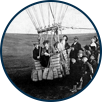 Cosmic Rays Discovery
Cosmic Rays Discovery
Austrian physicist Victor F. Hess discovers cosmic-rays in a series of ascents in a hot-air balloon while looking for the source of the ionization radiation observed in the ground and in the atmosphere. His highest ascent was at 5.3 km of altitude. (Phys. Zeitshr. 13, 1084)
1936
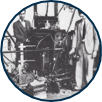 Muon Discovery
Muon Discovery
American physicist Carl D. Anderson and his graduate student Seth Neddermeyer discovered the existence of muon particles. The first observation of a muon was in a cosmic-ray. (Phys. Ver. 51, 884)
1955
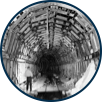 First Use of Muons
First Use of Muons
First reported use of cosmic-ray muons by Eric George to measure the ice thickness above a tunnel in Australia. The work used spark chambers to detect the muons. (Commonwelth Engineer July 1, 455)
1967
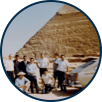 Muon Radiography in Chephren Pyramid
Muon Radiography in Chephren Pyramid
Muon radiography is used by Luis Alvarez team to look for hidden chambers in Chephren Pyramid in Egypt. The detection was made with spark chambers and scintillation counters. No additional chambers were found at that time. (Science 176, 832)
1987
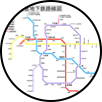 Measurement Depth of Nagoya Subway Tunnels
Measurement Depth of Nagoya Subway Tunnels
Minato et al. measured the depths of Nagoya subway tunnels using cosmic-ray muons. The detectors used were based in scintillation counters. (Minato et al. 1987)
1999
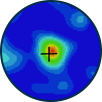 Moon Shadow is Imaged using Muons
Moon Shadow is Imaged using Muons
At the Soudan II detector in Minnesota, using drift tubes and at an undergroud depth of 700m, the Moon shadow is imaged using muon flux. (Cobb et al. 1999)
2003
 Preparation to Inspect the Pyramid of the Sun
Preparation to Inspect the Pyramid of the Sun
The preparations on a muon detector system are iniciated to inspect the interior of the Pyramid of the Sun in Mexico. Some of the detection system uses scintillation counters. (Alfaro et al. 2003)
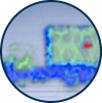 Beginning Applications of Muon Scattering Tomography
Beginning Applications of Muon Scattering Tomography
At LANL, a seminal work on utilising Coulomb scattering of muons to identify high-Z objects is made aiming the detection of nuclear treats. (Borozdin et al. Nature 422, 277. 2003)
2007
 Density Measurement of Mt. Asama
Density Measurement of Mt. Asama
Muography is used by Tanaka et al. to measure a density profile of Mt. Asama and the 1944 Usu lava dome, both in Japan. The method used is based in emulsion cloud chambers. (Tanaka et al. 2007)
2008
(Legnato National Laboratory Simulation and Prototype)
2009
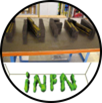 INFN Muon Tomography System
INFN Muon Tomography System
The large-volume muon tomography system, built by INFN, demonstrates the possibility of material discrimination. The system is based on drift chambers. (Presente et al. 2009)
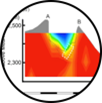 Density Profile of a Volcano Interior
Density Profile of a Volcano Interior
The density profile of the interior of a volcano in Japan is imaged with cosmic-ray muography combined with classical gravimetry by Okudo and Tanaka. (Okubo and Tanaka, 2012)
2010
Puy de Dôme Vulcan Struture Study
(Cristina Carloganu)
2012
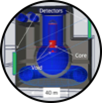 Fukushima-Daiichi Plant Interior Simulation
Fukushima-Daiichi Plant Interior Simulation
Simulation studies show the feasibility of identifying voids and movements of the material inside the reactor core at the stricken Fukushima-Daiichi plant. (Borozdin et al. 2010)
2013
Muon Tomography in Mars
The California Institute of Technology proposed the use muons to map the terrain of Mars. Studies found that muon flux present on martian atmosphere is on par with what is observed in the Earth atmosphere. (Kedar et al. 2014)
2014
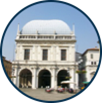 Palazzo della Loggia Monitorization
Palazzo della Loggia Monitorization
A monitorization system based in muon tomography is installed at Palazzo della Loggia, dating from 1574 in Italy, to monitoring the integral stability of this historical building. (Zenoni et al. 2014)
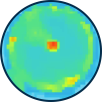 Nuclear Waste Control
Nuclear Waste Control
The first images of encapsulated nuclear waste were obtained by the Sellafield Muon Tomography project using a small-scale prototype detector system in Glasgow.
2016
WatTo Experiment
2017
ScanPyramids Project - Cheops Pyramid New Chamber
More Info
